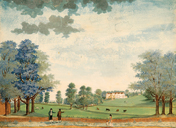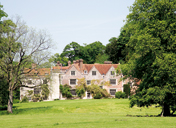HOUSE AND ESTATE
THE ESTATE
The gardens
South Lawn
During the period 1763-1780, Chawton House's formal gardens as depicted in the famous painting by Mellichamp c.1740, were swept away and replaced by the English Landscape style. As Jane Austen noted in Mansfield Park, this particular change tended to be both revolutionary and destructive, producing a marked change in garden history. The essence of the style was that the house should be surrounded by parkland with Arcadian lawns sweeping right up to the walls of the house in a naturalistic landscape. Views from and towards the house were very important, and clumps of trees were placed, not only to avoid blocking views, but also to frame them. The grazing animals were an integral part of the landscape, keeping the grass short in the parkland with the impression that they could graze right up to the house by putting in a Ha-Ha.
The South Lawn and the views from and towards the house have been reinstated as closely as possible to the view portrayed in a watercolour c.1780 by Adam Callender. The view to the south west is open, crossed by the Ha-Ha. To the south lies the eigtheenth-century Wilderness. The lawn retains its informal character, as originally intended.


